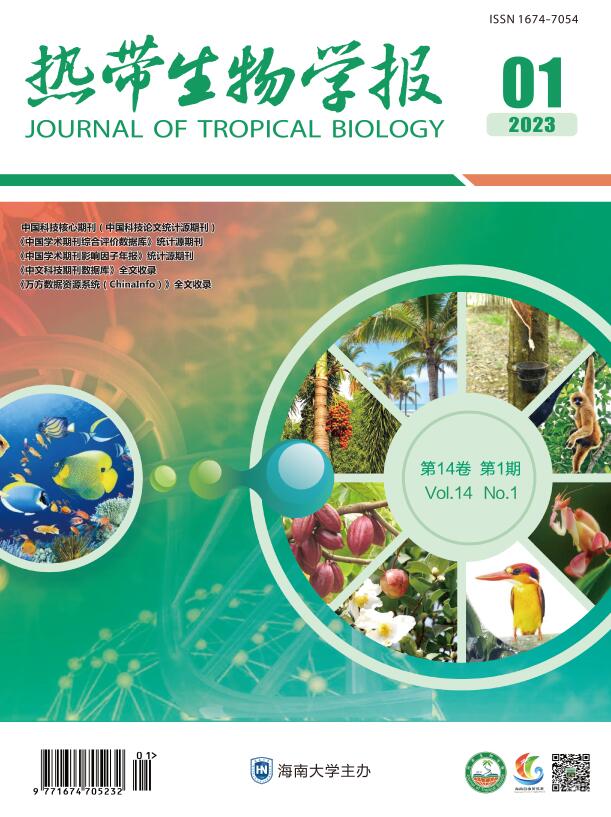-
广州管圆线虫(Angiostrongylus cantonensis)是一种人兽共患食源性寄生虫病——广州管圆线虫病(Angiostrongyliasis cantonensis)的病原,隶属于线虫目,后圆线虫科,后圆线虫亚科,管圆线虫属[1],广泛分布于热带及亚热带地区,引起重大的公共卫生问题[1-2]。由于其适宜在25~30 ℃的潮湿环境中发育,因此在我国主要分布于浙江、福建、江西、湖南、海南、云南、广西和广东等地[2]。A. cantonensis生活史较复杂,鼠类是A. cantonensis的终末宿主,中间宿主包括陆生和水生软体动物。保虫宿主可以是淡水鱼、虾、蟹、蟾蜍、青蛙,也可以是包括人、猫、犬在内的几十种哺乳动物[3-5]。人作为其非适宜宿主,主要通过摄入感染性幼虫污染的食物而发生感染,引起嗜酸性粒细胞增多性脑膜炎(eosinophilic meningitis, EM)。广州管圆线虫病相对罕见,但随着人们生活方式与饮食习惯的改变,广州管圆线虫病患者越来越多,如今世界累计报告病例已超过3000例。世界卫生组织(WHO)已将广州管圆线虫病列为21世纪新出现的全球威胁性传染病之一。在医疗上通常根据食用软体动物史、临床特征及实验室检查做出推定诊断,但目前已开发出的针对广州管圆线虫病的血清学检测的多种诊断方法的灵敏度及特异性仍有待提高。增加对广州管圆线虫病的认识将有助于快速诊断并改善临床结果,为此,笔者重点对广州管圆线虫的病原生物学、流行病学、发病机理、免疫机制及诊断技术的研究进展进行了概述。
-
A. cantonensis虫卵卵壳较薄、无色透明、形状不一,多为椭圆形,且新鲜的虫卵多处于单细胞期,因此常难以检获[6]。Uga S等人[7]证实超过50%的A. cantonensis虫卵在−30 ℃的温度条件下存活,且随着温度下降,虫卵的存活率显著降低,在−50 ℃时存活率低于10%。
-
A. cantonensis幼虫可分为5期,第Ⅰ期幼虫:体表无色透明;尾端细尖,近尾端背侧有一明显刀切样凹陷。第Ⅱ期幼虫:体表具鞘;体内尤其是食管与肠管交界处含有大量折光颗粒[8]。第Ⅲ期幼虫:虫体明显膨大增粗,呈细杆状;体表由外层鞘膜和内层皮层组织构成;头部顶端圆钝,尾部尖,聚集实质细胞。第Ⅳ期幼虫:虫体雌雄区分明显,长度约为Ⅲ期幼虫的2倍;雄虫尾部膨大,出现交合刺和交合刺囊;雌虫前端可见双管形子宫,阴道和肛孔位于虫体末端。第V期幼虫:虫体体积较IV期增大;雄虫已形成交合伞;雌虫卵巢膨大,阴门明显。张超威等[9]发现中间宿主福寿螺体内的部分Ⅲ期幼虫已褪去鞘膜,仅腹部留有痕迹,但仍有部分Ⅲ期幼虫在继续脱鞘发育,其特征为尾部末端有一段短小纤细圆柱体。另有少数虫体体内已出现IV期幼虫才有的亚腹腺和双管子宫结构,但其是否能在中间宿主体内继续发育至IV期幼虫仍有待探索。
-
A. cantonensis成虫呈两端略细的线状,角皮透明、光滑,体表有清晰可见的微细环状横纹。雄虫尾部略向腹部弯曲,多呈“肾”形,有一个对称的交合伞;雌虫通常比雄虫大,尾部多呈斜锥型,体内子宫与肠管相互缠绕,在显微镜下可以清晰看到红(或黑褐)白相间的结构[10]。
-
A. cantonensis生活史较复杂,可以在保虫宿主、中间宿主和终末宿主体内移行或发育。保虫宿主可以是淡水鱼、虾、蟹、蟾蜍、青蛙,也可以是包括人、猫、犬在内的几十种哺乳动物 [3-5]。中间宿主多为软体动物,如螺类(福寿螺、皱疤坚螺、中国圆田螺、褐云玛瑙螺、东风螺、明线瓶螺、铜锈环棱螺等)、蛞蝓类(足襞蛞蝓、双线嗜粘液蛞蝓等)和蜗牛类(同型巴蜗牛、短梨巴蜗牛等)[3]。终末宿主为啮齿动物,如褐家鼠、黑家鼠、黄胸鼠和黑线姬鼠等鼠类。A. cantonensis成虫在终末宿主的肺动脉内雌雄交配产卵,虫卵孵化后,I期幼虫穿破肺毛细血管进入肺泡,延支气管上行至咽喉,并随着呼吸道分泌物进入消化道,最后随粪便排出体外。I期幼虫进入中间宿主体内后可移行至肺、肝脏、肌肉等处寄生;幼虫经2次蜕皮发育为Ⅲ期幼虫。终末宿主吞食含有III期幼虫的中间宿主或被III期幼虫污染的蔬菜或水源时而发生感染[11-12]。另一方面,保虫宿主同样会因为误食了感染性III期幼虫而发生感染。在保虫宿主体内,虫体虽然可以继续发育为IV期、V期幼虫或童虫,但不能发育为性成熟的成虫[13]。杨发柱等[5]发现,犬和猫作为保虫宿主经口感染III期幼虫后未出现异常表现,体内也检测不到虫体;而猫经皮下注射III期幼虫后虽可导致感染,但只有在表现出明显症状时,才能在脑及脊髓中检测到幼虫,症状消失之后,亦检测不到虫体,因此,猫可以成为研究广州管圆线虫病治疗方案及机体清除A. cantonensis机制的动物模型。
-
1984—1996年我国广州管圆线虫病确诊病例仅有4例,之后十余年,在浙江、福建、江西、北京、辽宁、云南、湖南、广东、广西、海南和台湾等地区均出现过因生食、半生食福寿螺导致的广州管圆线虫病暴发流行 [14-19]。2010—2012年流行病学调查[20]证实海南全省各地居民普遍存在A. cantonensis感染情况,血清学检测平均阳性率达20.04%,个别县高达49.45%。截至2017年,全国各地累计报道病例高达521例[21],其中广西和福建的感染率最高,其次是云南。
人主要通过生食或半生食A. cantonensis的中间宿主而发生感染,因此对中间宿主感染率及流行情况进行调查具有重要的意义。2008年对广东省深圳西南部褐云玛瑙螺体内A. cantonensis感染率进行调查,数据显示其阳性感染率高达31%,同时,检出阳性螺的区域内A. cantonensis终末宿主褐家鼠和黄胸鼠也存在感染现象,感染率平均为12%[22]。2009年对浙江省A. cantonensis的不同中间宿主的感染情况进行调查,调查数据显示温州市福寿螺感染率达到69.4%[23],丽水市蛞蝓感染率更是高达80.65%[24]。2012年在福建省福州、厦门的菜市场和餐饮店销售的福寿螺和铜锈环棱螺中[25]以及2015年在龙海市居民居住环境中采集的褐云玛瑙螺中均检出A. cantonensis幼虫[26]。2021年,郑丹等[27]对流行病学调查结果显示,在福建省多市县的农贸市场、超市、早市以及路边摊上未发现福寿螺和褐云玛瑙螺售卖,这可能是政府宣传教育及加大管理力度的结果,但在野外及居民居住环境中采集的福寿螺和褐云玛瑙螺中仍存在A. cantonensis感染。2022年最新流行病学数据显示,广州市不同地区城市公园中的不同种类中间宿主的感染率存在明显差异,其中,褐云玛瑙螺和蛞蝓的感染率较高,分别为16.5%和14.9%[28]。
除上述重要疫源地以外,2020年3月首次在四川省自贡市贡井区确认2例A. cantonensis本地感染病例,且这2名患者均有生食淡水螺史。在患者食用淡水螺的水田周围采集福寿螺,螺体感染率为10.69%[29]。在患者家周围菜地、房屋前后和鱼塘边捕捉到的双线嗜粘液蛞蝓体内也检测到了A. cantonensis Ⅲ期幼虫[30]。随着经济的发展,不同地区人们的饮食习惯日益融合,因此,除了加强重要疫源地调查外,还应掌握全国各省市螺类分布情况以及螺类和鼠类A. cantonensis感染情况。
-
广州管圆线虫病潜伏期一般为3~30 d,少数患者当天即可发病,出现恶心、腹痛、腹泻和呕吐等非特异性症状和体征,小部分患者会出现斑丘疹或荨麻疹等皮肤性症状。早期症状持续数日后便可自行消散,随后出现持续数天至数周的无症状期。在病程后期,患者会产生以发热、头痛、颈部僵直为主要临床表现的嗜酸性粒细胞增多性脑膜炎(eosinophilic meningitis, EM)[31]。严重者还会出现面部、肢体麻痹、单侧视力下降、失明、昏迷,甚至死亡[32]。
由于寄生虫感染数量及寄生部位的不同,广州管圆线虫病患者体内的病变通常是多灶性的[33]。例如,遭受免疫系统攻击的移行期幼虫的遗骸很可能在中枢神经系统中持续存在数月至数年,诱导周围组织出现慢性炎症反应,同时,胶质细胞的增生会导致永久性疤痕组织沉积。另一方面,逃避宿主免疫系统攻击的幼虫会通过脑静脉和脊髓静脉离开中枢神经系统,到达肺部。当大量幼虫在肺动脉中寄生时,会导致患者出现严重的肺部疾病[34]。因此,尽管进行了及时的诊断和治疗,感染A. cantonensis也会使许多患者出现长期甚至是永久性的后遗症。
-
迄今为止,针对广州管圆线虫病的治疗主要采用对症和支持疗法。苯并咪唑类药物(阿苯达唑、甲苯达唑、噻苯达唑和芬苯达唑)、伊维菌素和左旋咪唑已被广泛用于治疗广州管圆线虫病。Jacob等[35]通过体外研究分析多种驱虫药对A. cantonensis Ⅲ期幼虫的药效,结果表明阿苯达唑和伊维菌素/莫西菌素可用于广州管圆线虫病的治疗,而双羟萘酸噻嘧啶则可作为预防广州管圆线虫病的候选药物。Jhan等[36]发现阿苯达唑和地塞米松等药物联合治疗EM的效果更佳。Lin等[37]研究发现生姜的部分成分也可用于抗A. cantonensis感染,但受病情严重程度、治疗方案、治疗时机、年龄体质等多因素的影响,治疗效果及治疗周期会存在些许个体差异。
-
(1)改变饮食习惯。A. cantonensis主要感染途径是经口感染,所以要注意饮食卫生,改变生食或者半生食食物的习惯,特别是醉蟹、醉虾及爆炒田螺等。(2)淡水螺类和鼠类分别是A. cantonensis主要中间宿主和终末宿主,应加强鱼塘、稻田、居住地垃圾堆等周围环境的清理整治,切断该病原体的传播途径。
-
A. cantonensis感染是引起嗜酸性粒细胞增多性脑膜炎(EM)的典型原因,可导致中枢神经系统严重损伤。寄生虫和宿主因素都有助于EM的发生,但相关的免疫-炎症发病机制仍不明确。
-
A. cantonensis感染的免疫应答与宿主的自我保护和线虫的发病机制密切相关。T细胞和B细胞免疫在抵抗感染中起着至关重要的作用。A. cantonensis感染导致小鼠免疫功能明显减弱,表现为进行性脾、胸腺萎缩,且这种萎缩与脾细胞增殖减少及凋亡增加而导致细胞总数减少有关,其中T细胞亚群结构也会发生改变,如CD4+T/CD8+ T细胞比值和B/T细胞比值降低, CD4+CD25+Foxp3+ Treg、CD8+CD28- T和CD38+ T淋巴细胞比例增加[38]。但Chen 等[39]则认为脾脏和胸腺细胞的急剧减少不是由于细胞凋亡,而是由于B细胞生成的停止和胸腺细胞发育的受损而引起的。
Lee等[40]发现C57BL/6小鼠感染A. cantonensis后,外周血中CD4+ T和CD8+ T细胞的百分比显著增加,且T细胞耗竭小鼠体内的虫荷数明显多于未耗竭小鼠,将感染小鼠体内CD4+ T细胞过继转移至同系感染小鼠可以介导保护作用,但过继转移CD8+ T细胞群则无保护作用。Aoki等[41]的研究结果同样证实,抗CD4抗体处理会增加感染A. cantonensis的BALB/c小鼠的发病率,而抗CD8处理则不会提高其发病率。Liu等[42]通过流式细胞术检测感染A. cantonensis小鼠脾细胞中T细胞亚型分化情况,实验结果表明,感染小鼠脾细胞中CD4+和CD4+IL-4+ T细胞百分率明显增加,而CD4+IL-17+和CD4+IFN-γ+ T细胞的百分率则显著降低;此外,感染组小鼠脾细胞培养上清中白细胞介素(Interleukin, IL)-4浓度明显升高,但IL-17显著降低;说明A. cantonensis感染诱导小鼠体内CD4+ T细胞向Th2表型分化,而Th17细胞分化受到抑制;由于Th2细胞主要发挥抑制免疫反应的作用,Th17细胞参与介导炎症反应的发生与发展,所以推测A. cantonensis可能通过诱导Th2细胞为主的T细胞应答,从而有利于其在宿主体内的长期存活。
A. cantonensis感染宿主的发病率和死亡率存在种系依赖性差异,那么不同种系之间的免疫应答机制是否同样存在差异呢?刘珍等[43]检测了A. cantonensis感染对大鼠胸腺及脾脏中T细胞各亚群的影响,结果发现大鼠胸腺中CD4+、CD8+、CD4+CD8+和CD4-CD8-T细胞比例和数量在感染21 d后与对照组相比无显著性差异,而脾脏中CD4+/CD8+ T细胞比值显著增加,且大鼠胸腺、脾脏及脑组织中单个核细胞各亚群变化同样不明显。胸腺作为中枢神经系统,是T细胞发育分化的场所,在感染后期,胸腺中T细胞各亚群无显著变化,说明此时大鼠体内的炎症反应已经得到缓解,无需更多的免疫细胞发挥调控作用,同时,脑组织中单个核细胞变化不明显也进一步证实脑组织中炎症反应得到缓解,而脾脏中CD4+/CD8+ T细胞比例增高,说明CD4+ T细胞主要发挥清除和控制感染的作用。简而言之,在大鼠体内CD4+ T细胞通过清除和控制感染可使脑部炎症反应在感染后期逐渐得到缓解,这与以小鼠为研究对象获得的实验结果相一致。
-
当机体发生感染时,活化的嗜酸性粒细胞(eosinophil, EOS)可迁移至外周血中,随后被募集到组织中并分泌高水平细胞因子、趋化因子、脂质调节物和细胞毒性颗粒蛋白等,从而迅速引发并维持局部炎症反应[44]。研究结果表明,在A. cantonensis感染过程中,一方面EOS能通过分泌颗粒对A. cantonensis幼虫发挥杀灭作用;另一方面其释放的EOS阳离子蛋白(eosinophil cationic protein, ECP)和EOS蛋白X(eosinophil protein X)也会造成神经系统损伤[45-46]。EOS(以及其他免疫细胞,如T细胞)也被证明可以产生、储存和释放神经营养因子,如脑源性神经营养因子(BDNF)[47,48]。有研究结果表明,在中枢神经系统中局部产生的BDNF可以减轻炎症依赖的神经元损伤[49]。
-
在中枢神经系统病变中常观察到小胶质细胞和星形胶质细胞的激活,以及各种炎症反应信号通路的活化[50]。小胶质细胞正常情况下处于静息状态,当小胶质细胞被激活后可发挥“双刃剑”作用,一方面活化的小胶质细胞可通过分泌细胞因子和神经生长因子促进神经组织修复;另一方面小胶质细胞又可通过释放细胞毒素、炎症介质及细胞因子加重脑组织损伤[51],活化的小胶质细胞可以产生IL-4、肿瘤坏死因子(tumor necrosis factor, TNF)-α等促炎因子,高水平表达诱导型一氧化氮合酶(inducible nitric oxide synthase, iNOS),释放活性氧(reactive oxygen species, ROS)和一氧化氮(NO)等毒性介质也具有杀死寄生虫作用[52]。Wei等[53]发现在A. cantonensis感染过程中,胶质细胞的激活以及神经毒性炎性因子的释放破坏了神经系统生理平衡,导致中枢神经损伤。因此,小胶质细胞活化与A. cantonensis感染后EOS浸润所引起的脑炎和脑膜脑炎具有一定相关性。
-
Sugaya等[54]发现小鼠的脑脊液、血清和脾细胞或颈淋巴细胞培养上清液中IL-5和IL-4的产生水平显著增加,这说明全身和局部Th2细胞因子反应,特别是涉及IL-5的反应,在A. cantonensis感染的小鼠中占主导作用。IL-5在A. cantonensis感染小鼠的EOS反应中同样是必不可少的[55]。通过检测30例嗜酸性粒细胞性脑膜炎伴广州管圆线虫病(EOMA)患者脑脊液中细胞因子的表达情况,同样证实在EOMA患者脑脊液中局部Th2细胞因子应答占据主导地位,同时,IL-5、IL-10和TNF-α产生水平与EOS浸润水平相关。因此,脑脊液中Th1/Th2细胞因子的测定对寄生虫相关脑膜炎的诊断也具有一定的潜力[56-57]。
Chuang等[58]研究发现,在ST2单抗治疗A. cantonensis感染小鼠后,血清中IL-5水平明显降低,嗜酸性粒细胞在脑膜的浸润也明显减少,因此推测IL-33/ST2轴可能在广州管圆线虫病的发病机制中起着至关重要的作用。Peng和Du等[59-60]也通过一系列实验证实,在A. cantonensis感染过程中,大脑中的IL-33和ST2L mRNA转录水平显著上调,同时,IL-33诱导脾细胞和大脑单个核细胞产生IL-5和IL-13。此外,给予A. cantonensis感染小鼠IL-33后,ST2L的表达和细胞因子的产生均有所增强。因此,大脑中产生的IL-33可能在A. cantonensis诱导的EM中发挥炎症介质的作用。
-
伴随着A. cantonensis的感染,宿主免疫应答会同时启动趋化因子和趋化因子受体来阻止寄生虫的入侵、移行等行动。幼虫在感染后第2天即迁移到宿主脑组织,随着感染时间的延长,在幼虫刺激下神经元和星形胶质细胞释放趋化因子。Li等[61]发现Cys-Cys(CC)型趋化因子CCL2、CCL8、CCL1、CCL24、CCL11、CCL7、CCL12、CCL5在感染晚期显著升高;同时,脑脊液中EOS增加趋势与趋化因子水平变化趋势基本相关,因此说明趋化因子在招募EOS的过程中发挥重要作用。
Ym1作为一种嗜酸性趋化因子,对T淋巴细胞和骨髓细胞同样具有趋化活性。有报道称,在寄生虫感染过程中,Ym1是由活化的巨噬细胞合成和分泌的[62]。在大脑中,小胶质细胞是交替激活的巨噬细胞源性细胞,是参与中枢神经系统炎症的关键免疫细胞。Zhao等[63]的研究结果表明,Ym1在感染A. cantonensis的小鼠的大脑和脑脊液中随着炎症的发生而大量表达,且Ym1比IL-5和IL-13的变化更明显。通过抗体定位实验也证实Ym1由大脑小胶质细胞合成并分泌。因此,Ym1可能作为一种替代的潜在病理标记物。
Chang等[64]发现A. cantonensis感染小鼠脑脊液中嗜酸性粒细胞活化趋化因子(eotaxin)和巨噬细胞炎症蛋白(MIP)-1α同样具有EOS趋化活性,且eotaxin的释放具有时间依赖性和蠕虫负荷依赖性[65]。Intapan等[66]通过检测30例患者的脑脊液中eotaxin和eotaxin-2的浓度,进一步证实脑脊液中eotaxin-2水平与嗜酸性粒细胞增多相关。这些结果提示患者EOS聚集到大脑和脊髓可能与eotaxin-2水平升高有关。
-
寄生虫的排泄-分泌产物(ESP)作为生物活性分子可直接与宿主的免疫系统相互作用。A. cantonensis IV期幼虫的ESP具有诱导巨噬细胞选择性激活的能力[67]。V期幼虫的ESP可以通过激活NF-κB和Shh信号通路刺激星形胶质细胞活化和细胞因子生成[68]。同时,V期幼虫的ESP还可以通过激活抗氧化剂导致氧化应激水平的降低,进而激活星形胶质细胞内Shh信号通路,发挥抗凋亡作用。Shh(sonic hedgehog, 音猬因子)信号通路主要在发育过程中发挥控制神经祖细胞、神经元和神经胶质细胞的形成的作用[69]。对于EOS而言,A. cantonensis成虫的ESP不显示出趋化活性,而其体蛋白则具有一定的趋化活性,且呈蛋白浓度依赖性。Wang等[70]进一步通过ELISA检测发现,体蛋白中半乳糖凝集素-9样(galectin-9-like)蛋白在趋化EOS方面发挥重要作用。在中枢神经系统中,壳多糖酶3样蛋白3(chitinase 3-like protein 3, CHI3L3)具有诱导少突胶质细胞形成髓鞘的能力。Wan等[71]研究发现,A. cantonensis可溶性抗原可以通过增强IL-13与CHI3L3之间的正反馈环路诱导EM的发生与发展。但无论是ESP还是体蛋白都是多种蛋白组成的混合物,其成分复杂,下一步的研究重点应放在分析其中某一具体的抗原成分在A. cantonensis与宿主免疫互作的过程中所发挥的关键作用。Sun等[72]研究发现在IV期幼虫和成虫体内高表达的半乳糖凝集素-1(Galectin-1, Gal-1)可以通过减少脂肪沉积,对氧化应激引起的损伤发挥防御作用,这可能提示了A. cantonensis在人类中枢神经系统EOS的免疫攻击下存活的机制。另外,Gal-1可通过与膜联蛋白(Annexin)A2结合,激活JNK下游凋亡信号通路诱导巨噬细胞凋亡[73]。因此,Gal-1可能在A. cantonensis免疫逃避机制中扮演重要角色。
-
越来越多的证据支持miRNA在A. cantonensis感染引起的EOS增多性脑炎和脑膜脑炎发生与发展过程中发挥重要的调节作用。研究结果显示,在被A. cantonensis感染后的不同时长中小鼠脑内miRNA表达存在明显差异,大多数差异表达的miRNAs参与了免疫反应,特别是EOS分化的调节,且随着感染时间的延长而发生动态变化[74]。另一方面,不同发育阶段的A. cantonensis本身miRNA表达亦存在较大差异[75]。
综上所述,A. cantonensis与宿主之间的免疫互作机制需要固有免疫细胞、外周免疫细胞以及细胞因子和趋化因子等共同参与,因此,免疫细胞及相关因子的炎症调节机制与miRNA的转录调节机制在A. cantonensis的研究中有着重要的地位。
-
广州管圆线虫病的诊断首先需要考虑近期流行病学资料,如患者近2个月是否有意或无意地摄入螺类(中间宿主)、食用未煮熟、未洗过或洗得不充分的受污染的蔬菜水果[76],然后结合临床表现(有无发热、头痛等神经系统症状)及实验室辅助检查(如脑脊液检查、血清抗体检查等)进一步确定。目前还没有明确作为首选的诊断方法,且由于广州管圆线虫病临床症状与其他多种疾病症状相似,缺乏明显的典型性,导致该病往往不能及时确诊,容易出现误诊和漏诊现象。
-
早年广州管圆线虫病的诊断,主要依赖于病原学检查,只有在脑脊液等标本中检测到虫体才能作为确诊依据。但A. cantonensis幼虫侵入人体的中枢神经系统后,绝大部分幼虫不再继续发育而停留在脑部,或被宿主免疫系统及药物及时清除,因此患者脑脊液中幼虫的检出率极低。但A. cantonensis的感染会导致患者脑脊液中蛋白含量升高,其外观表现为浑浊或乳白样状态。磁共振影像学特征显示,五分之四的患者脑实质病变呈弥漫性或散在分布,少数患者出现脑室扩增的现象[77]。同时,血常规检测结果显示白细胞及嗜酸性粒细胞数量会随患者病程延长而逐渐升高[78]。
-
尽管早期使用的酶联免疫吸附试验(ELISA)、间接血凝试验(IHA)、间接免疫荧光抗体试验(IFAT)、反免疫电泳(CIE)等方法进行检测并未得到预期的效果,但随着技术的发展和改进,免疫学诊断方法因简单、廉价和快速的特点而被认为是目前最适当的诊断方法。
-
在过去的几十年里,主要利用A. cantonensis成虫粗提抗原或部分纯化抗原、脑期幼虫的排泄-分泌产物等进行免疫学检测[79]。Maleewong等[80]对A. cantonensis雌虫体蛋白提取物(adult female worm somatic extract, FSE)的抗原成分进行了检测,并通过免疫印迹分析广州管圆线虫病患者血清及脑脊液对FSE的反应性,结果发现29 kDa抗原带可作为可靠的诊断指标。
Eamsobhana等[81-83]通过电洗脱方法从A. cantonensis成虫体蛋白粗提物中得到了高纯度的31kDa糖蛋白,并利用dot-blot ELISA检测方法对广州管圆线虫病患者血清样本进行检测,检测结果表明,该诊断方法灵敏度和特异性均高达100%。2018年,Eamsobhana等[84]开发了一种快速横向流动免疫层析法(AcQuickDx试验)来检测人血清中的抗A. cantonensis抗体,该方法具有检测速度快,灵敏度和特异性高等特点。最近,Eamsobhana等[85]又新建立一种双夹心斑点免疫金渗滤法(sandwich dot-immunogold filtration assay, DIGFA),该方法能够在临床样本中快速定性检测A. cantonensis特异性31 kDa抗原。
除上述检测方法之外,免疫印迹也是一种常用的,较为简单的免疫学检测方法。Vitta等[86]建立的81 kDa重组蛋白免疫印迹检测方法的特异性及灵敏度均大于90%,但与多种寄生虫病患者血清存在交叉反应。16 kDa重组蛋白免疫印记诊断方法的特异性高达100%[87],更为重要的是,16 kDa重组蛋白免疫印记诊断方法与感染了棘颚口线虫(Gnathostoma spinigerum)和猪囊尾蚴(Cysticercus cellulosae)的患者血清中的抗体无交叉反应,这两种感染在临床上表现出类似于广州管圆线虫病的神经症状;这些数据表明,16 kDa重组蛋白是一种具有高潜力的广州管圆线虫病血清诊断候选抗原。
由于A. cantonensis幼虫可以寄生于脑室,因此,血清抗体浓度可能保持在很低的水平,从而影响了血清学诊断的准确性。Chye等[88]用特异性单克隆抗体通过免疫亲和层析法纯化了来自A. cantonensis V期幼虫(AcL5)的抗原,SDS-PAGE分析显示纯化的抗原为204 kDa的单条带,将纯化的抗原作为包被抗原建立ELISA检测方法,与其他几种寄生虫诱导的抗体无交叉反应;同时,使用该ELISA方法检测血清和脑脊液标本时,血清中抗体水平略高于脑脊液中抗体水平,因此该方法检测血清抗体的可靠性略高于检测脑脊液标本抗体的可靠性。
-
感染后抗体延迟出现及治愈后抗体持续存在等情况限制了血清抗体检测诊断的可靠性。抗体检测的另一种替代方法是抗原检测。抗原检测证明宿主中存在虫体,同时,也可更迅速地确认急性或活动性感染。将A. cantonensis特异性单克隆抗体(AW-3C2)作为夹心ELISA捕获试剂,检测广州管圆线虫病患者血清中特异性循环抗原,其特异性为100%,但敏感性仅为50%[89]。在广州管圆线虫病患者的血清和脑脊液中,使用双单克隆抗体(AcJ1和AcJ20)进行检测,其特异性为100%[90]。Chye等[91]使用AcJ1单抗作为捕获抗体,通过免疫PCR(Immuno-PCR, Im-PCR)检测广州管圆线虫病患者血清中循环的204 kDa抗原,检测特异性为100%。同时,Im-PCR方法对已知感染A. cantonensis的患者的脑脊液标本的检测灵敏度为100%,对仅表现出临床症状的患者的脑脊液标本的检测灵敏度为96.7%。Liang及Tan等[92-93]利用成虫的3个特异性单克隆抗体(2A2、3F1、4H2)进行血清学检测,其阳性检出率为86.4%。
-
脑脊液收集和患者血清中低抗原浓度带来的诊断挑战促使人们开发更敏感的替代检测方法。近年新兴的宏基因二代测序病原检测方法具有精准、快速、阳性率高、覆盖度广等优势。罗智强等[94-95]采用宏基因二代测序技术在患儿外周血和脑脊液中均检测到A. cantonensis,因此该方法可以无创、快速且精准地诊断广州管圆线虫病。
-
虽然已经有许多针对A. cantonensis生物学方面(包括其生活史方面的试验数据)的研究资料,但目前对于该蠕虫与宿主之间的免疫互作机制仍知之甚少,因此,阐明A. cantonensis与宿主之间的互作机制具有重要的研究意义。同时,基因组学、蛋白组学、转录组学和生物信息学技术的快速发展也为探究寄生虫-宿主互作模式的研究提供支持。了解A. cantonensis免疫调控及免疫逃避机制,不仅可以为患者的早期快速诊断提供依据,也会为研发抗寄生虫药物,防治寄生虫感染提供新的策略。
Advances in epidemiology, immune regulation and diagnosis of Angiostrongylus cantonensis
doi: 10.15886/j.cnki.rdswxb.2023.01.001
- Received Date: 2022-11-18
- Accepted Date: 2022-12-15
- Rev Recd Date: 2022-12-08
- Available Online: 2023-01-01
- Publish Date: 2023-01-25
-
Key words:
- Angiostrongylus cantonensis /
- immunoregulation /
- angiostrongyliasis /
- immunological diagnosis /
- prevalence
Abstract: Angiostrongylus cantonensis is a zoonotic food-borne parasite, which has caused considerable public health problems in many countries in tropical and subtropical regions of the world. Humans, as unsuitable hosts, are infected by ingesting food contaminated by infective larvae of A. cantonensis, which cause eosinophilic meningitis. Angiostrongyliasis caused by A. cantonensis is expanding, and its cases have occurred in areas previously thought to be free of A. cantonensis. The prevalence of angiostrongyliasis showed that it is relatively rare in China, but the latest epidemiological data in 2022 showed that the infection rate of the intermediate hosts is relatively high. A presumptive diagnosis is usually made based on mollusk consumption history, clinical features, and laboratory examination. A variety of serological detection methods of angiostrongyliasis have been developed, but the sensitivity and specificity of many diagnostic methods remain to be improved. Increasing awareness of angiostrongyliasis will contribute to rapid diagnosis and improved clinical outcomes. A review was made of the researches in parasite biology, epidemiology, pathogenesis, immune mechanism, diagnosis, treatment and prevention of A. cantonensis.
| Citation: | XU Jingyun, ZHOU Yuchen, HUANG Shuo, HAN Qian. Advances in epidemiology, immune regulation and diagnosis of Angiostrongylus cantonensis[J]. Journal of Tropical Biology, 2023, 14(1): 60-70. doi: 10.15886/j.cnki.rdswxb.2023.01.001 |






 DownLoad:
DownLoad: